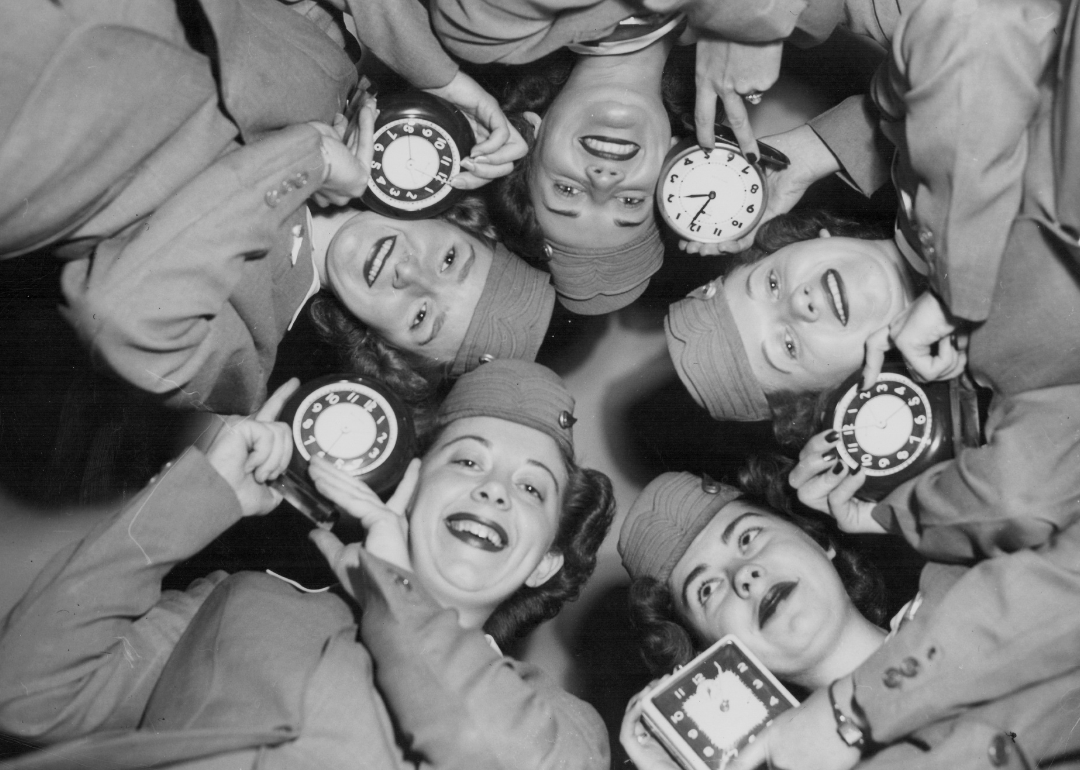
The history of daylight saving time—and why some are advocating for its end
The history of daylight saving time—and why some are advocating for its end
When asked about the origins of daylight saving time, you may imagine farmers in the distant past getting an extra hour of sun to tend to animals and crops. If you do, you're not alone. The myth that farmers are at the root of daylight saving time has proliferated a common understanding of the practice for a long time.
But if the agriculture industry didn't advocate for the start of daylight saving time—and evidence suggests that farmers were, in fact, opposed to its institution—then where did it come from?
The real story is bound up in numerous surprising factors, including the introduction of efficient railroads, wartime energy conservation measures, and the invention of standardized time zones. To learn more, Stacker turned back the clock to investigate the history behind daylight saving time—and why some people argue it shouldn't exist anymore—using news reports, historical records, and government memos.
The origins of daylight saving time
To trace the origins of daylight saving time, one needs to travel back to the 1880s, when more than 144 local time zones existed across the U.S. and most people relied on a sundial-esque tool called a noon mark to keep track of time. This lack of consistency in times mostly didn't matter until faster, more expansive railways began cropping up across the country. At that point, snafus in scheduling—missed connections and train collisions, for example—caused headaches for railroad companies and passengers alike.
Out of this chaos emerged the standardization of four major time zones in 1883, paving the way for new, more unified ways of timekeeping in the U.S. Thinking about changing the clocks to maximize sunlight hours, however, didn't start until the early 1900s. Germany was the first country to instate a daylight-saving time policy in 1916, and it was not for the benefit of farmers; rather, it was an attempt to save energy that would otherwise be used on lighting lamps as World War I raged.
Before Germany pioneered a national clock-changing policy, thinkers like British writer William Willett and even Benjamin Franklin had schemed about the potential benefits of daylight saving time, which included saving money on candles and lamp oil, as well as simply enjoying more sunlight during the colder months.
By the time the U.S. implemented its own daylight saving time policy in 1918—ostensibly to save fuel for the war effort—other parties were invested in the decision. The Chamber of Commerce, for instance, was a major supporter of the legislation, likely because leaving work while it's still light outside would encourage shopping and other economically stimulating activities in the evening hours.
However, the new law was unpopular among many Americans. Ironically, farmers were some of daylight saving's most vocal opponents because it decreased the vital early hours when farmers milk cows and harvest crops to bring to markets. Under pressure from the farm lobby, Congress repealed the measure by 1919.
Daylight saving time wasn't reinstated until 1942, when circumstances created by World War II made the policy a priority again. Daylight saving time was so associated with WWI that it was initially nicknamed "war time." By 1966, daylight saving time was federally standardized, and each state was mandated to either opt into changing the clocks twice yearly in observance of daylight saving time or opt out completely and adhere exclusively to standard time. Arizona and Hawaii were the only states to opt out due to their already sunny climates.
The world is moving away from the practice
Although daylight saving time has remained fairly consistent in the U.S. since 1966 (except for a brief Nixon-era policy in which daylight saving time became year-round in response to the oil embargo), when we change our clocks has shifted significantly. Initially, the change occurred every six months, but in 1986, daylight saving was extended to seven months out of the year. As recently as 2005, the timing shifted again, beginning an eight-month observance of daylight saving time.
Since 2015, several states have introduced legislation calling for the end of twice-yearly time changes, with many pushing for a permanent change to daylight saving time. Currently, federal lawmakers have stalled decision-making around the issue. Despite a bipartisan consensus that time changes should be scrapped, legislators disagree over whether there should be permanent daylight saving time or if reverting to permanent standard time makes more sense.
Supporters of permanent daylight saving time cite the economic benefits of longer daylight hours, as well as reduced seasonal depression. Critics, on the other hand, argue that the change would force those who have to wake up early, including children and teenagers, to go to school and work in complete darkness. Some organizations that study the science of sleep have also come out against permanent daylight saving time, citing its interference with natural circadian rhythms.
Outside North America and Europe, where most countries observe daylight saving time, the practice is far less common. Egypt is the only country in Africa that adheres to daylight saving time. There also seems to be a general global trend away from changing the clocks: Roughly half of the world's countries once observed daylight saving time but no longer do, with many countries changing their policies within the last decade, according to the Pew Research Center.
While the world seems to have left changing their clocks in the past, the push continues to eliminate twice-yearly time changes in the U.S., and most states will continue to "spring forward" and "fall back" for now.
Story editing by Carren Jao. Copy editing by Paris Close.



